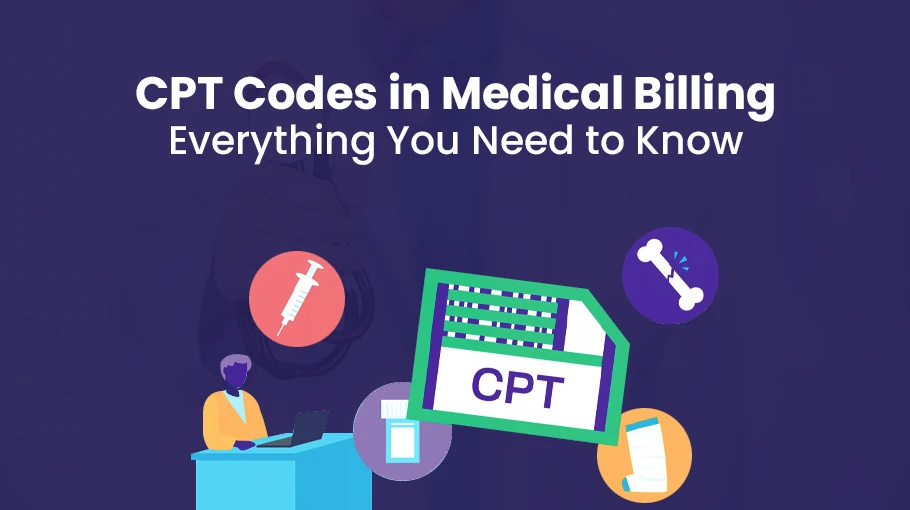Healthcare providers use Current Procedural Terminology (CPT) codes to communicate about medical, surgical, and diagnostic services. Understanding and effectively using CPT codes is crucial for accurately rendering medical billing and coding services. Let’s discuss the CPT codes in medical billing, their importance, and avoiding errors in CPT codes. Also, you will get a complete list of updated CPT codes.
What are CPT Codes?
Current Procedural Terminology (CPT) codes, are the standardized five-digit numeric codes used within the healthcare industry to accurately depict medical, surgical, and diagnostic services and procedures. Established by the American Medical Association (AMA), these codes serve as the universal language in healthcare, bridging the gap between healthcare providers and insurance companies.
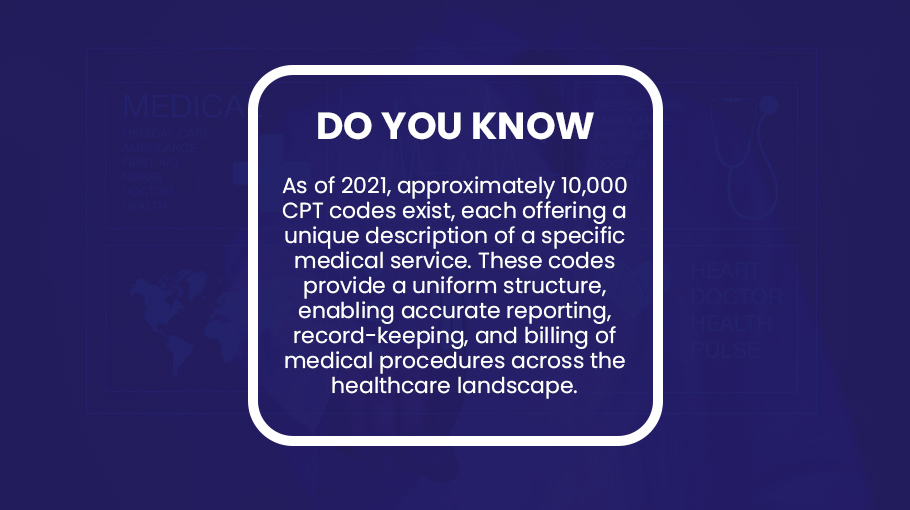
Categories of CPT Codes
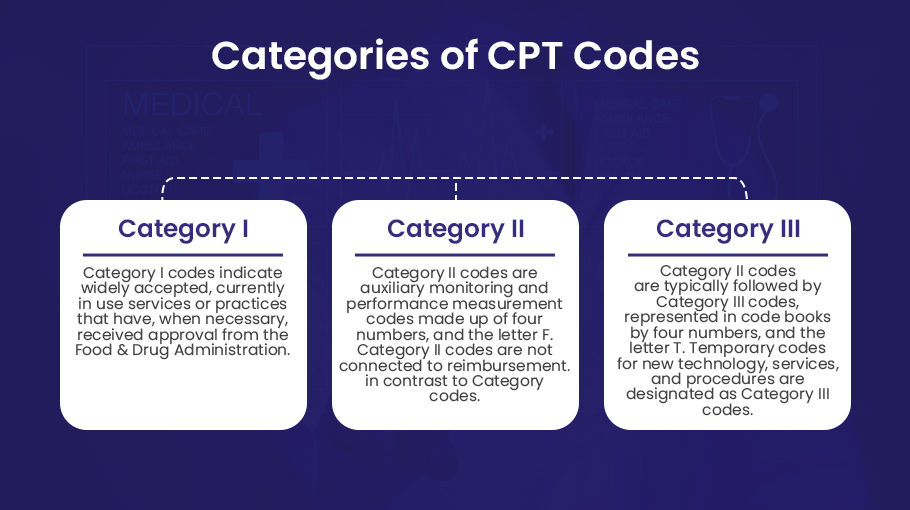
CPT codes are divided into three categories:
Category I Codes
Category I codes indicate widely accepted, currently in use services or practices that have, when necessary, received approval from the Food & Drug Administration.
There are very few exceptions to the rule regarding Category I codes, usually represented by five numeric characters. Codes that have been resequenced cause one difference from the expected order. The AMA “clusters” relevant codes together so medical coders can easily access them and make appropriate code selections. When a new code is added to a family of codes but a sequential number is not available, the code is resequenced.
Evaluation and management (E/M) codes represent a second exception to the numerical code order. Although E/M codes begin with 9, they are printed first in CPT® code books, as shown below in the Category I code outline. E/M services are the most often reported healthcare services. Hence, the AMA decided to list them in this order. Similar to resequenced codes, this arrangement is made to maximize coding effectiveness.
The CPT® Category I codes comprises six main sections:
- Evaluation & Management (99202–99499)
- Anesthesia (00100–01999)
- Surgery (10021–69990) — further broken into smaller groups by body area or system within this code range.
- Radiology Procedures (70010–79999)
- Pathology and Laboratory Procedures (80047–89398)
- Medicine Services and Procedures (90281–99607)
Category II Codes
In addition to Category I codes, providers may also use Category II codes, which are auxiliary monitoring and performance measurement codes made up of four numbers and the letter F. Category II codes are not connected to reimbursement, in contrast to Category I codes.
Providers employ Category II codes to improve patient care and outcomes, which track precise information about their patients, such as whether they smoke.
In your CPT® code book, Category II codes are often found just after Category I codes. Following is an arrangement of these codes:
- Composite Measures (0001F–0015F)
- Patient Management (0500F–0584F)
- Patient History (1000F–1505F)
- Physical Examination (2000F–2060F)
- Diagnostic/Screening Processes or Results (3006F–3776F)
- Therapeutic, Preventive, or Other Interventions (4000F–4563F)
- Follow-up or Other Outcomes (5005F–5250F)
- Patient Safety (6005F–6150F)
- Structural Measures (7010F–7025F)
- No measure Code Listing (9001F–9007F)
Category III Codes
Category II codes are typically followed by Category III codes, represented in code books by four numbers and the letter T. Temporary codes for new technology, services, and procedures are designated as Category III codes.
New services and processes’ temporary codes may stay in Category III for up to five years. The services and treatments they stand for will be given new Category I codes if they satisfy the requirements, which include FDA approval, proof that numerous providers undertake the procedures, and proof that the procedures are adequate. However, if providers don’t use them, Category III codes may be dropped.
The AMA posts updated or new Category III codes on their website every two years. However, they only publish the Category III deletions once a year, along with the complete list of temporary codes.
Structure of CPT Codes
Each CPT code is made up of five numerical digits:
- The first three digits represent the Category of the service or procedure. This classification helps identify the general nature of the medical intervention, such as surgery or radiology.
- The fourth digit provides information about the related body system or specific service area. This digit narrows the code to a particular location within the broader Category, like cardiovascular or respiratory systems.
- The fifth digit offers additional specificity or information about the service rendered. It helps differentiate between variations or techniques of the same procedure or service, allowing for more accurate documentation and billing.
This structure ensures that every CPT code is unique and precisely describes a specific medical service or procedure, making it easier for healthcare providers and insurance companies to communicate effectively and accurately regarding patient care.
Why Are CPT Codes Important?
CPT codes play a vital role in the healthcare sector by:
Clear Communication
These codes are a universal language, enabling clear communication between healthcare providers, patients, third-party payers, and data analysts.
Accurate Billing
CPT Codes provide a standardized mechanism for documenting and medical billing services rendered, ensuring that providers receive appropriate reimbursement.
Transparency
CPT codes make healthcare billing transparent and understandable for patients, reducing the likelihood of misunderstandings and disputes.
Analysis and Research
The standardization provided by CPT codes assists in collecting, analyzing, and interpreting national healthcare data.
Operational Efficiency
Implementing and maintaining an accurate CPT coding system can significantly enhance operational efficiency within a healthcare setting.
CPT Coding Accuracy: Best Practices
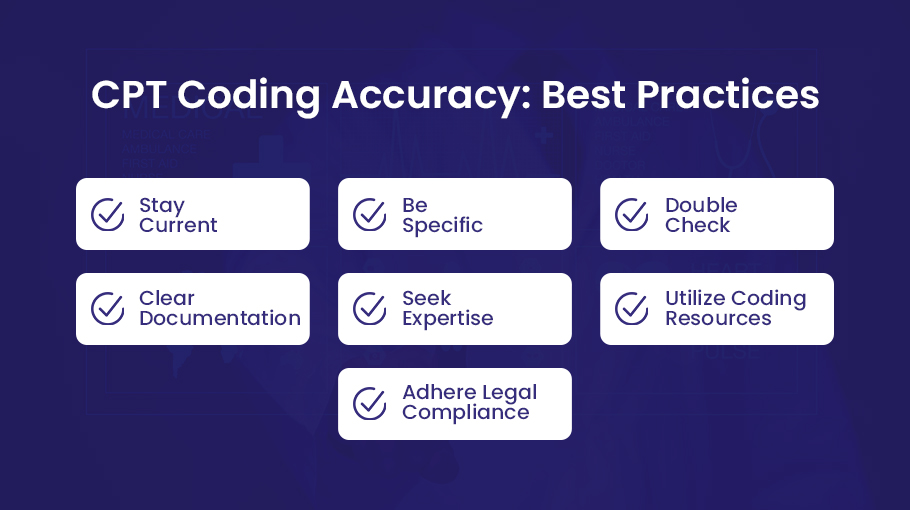
Understanding CPT codes is one thing; applying them is another. Here are some best practices to ensure accurate coding:
Stay Current
AMA frequently updates CPT codes to reflect changes in medical practice. It is crucial to stay updated with these changes.
Be Specific
Use the most specific code that accurately reflects the service provided. Avoid using unspecified codes unless necessary.
Double Check
Constantly review and double-check codes to avoid errors, which could lead to claim denials, delays, or incorrect payments.
Clear Documentation
Maintain clear, accurate, and detailed documentation for each patient encounter, as it serves as the foundation for correct coding and billing.
Seek Expertise
Invest in professional development and training for your staff to ensure they are well-versed in CPT codes and medical billing practices.
Utilize Coding Resources
Use reputable resources, such as the AMA CPT Codebook, online tools, or professional organizations, for proper code selection.
Compliance is Key:
Adhere to all relevant rules, regulations, and guidelines, including those set forth by the AMA, Centers for Medicare & Medicaid Services (CMS), and other regulatory bodies.
The Impact of Errors in CPT Coding
Mistakes in CPT coding can lead to various issues, including:
Delayed or Denied Payments
Inaccurate coding can result in claim denials, necessitating additional time and effort to rectify the errors and resubmit the claims.
Financial Losses
Undercoding or overcoding can lead to lost revenue or the risk of overpayment recovery by payers.
Audits and Penalties
Code errors can trigger audits, resulting in financial penalties, increased scrutiny, or legal consequences.
Damaged Reputation
Consistent errors in CPT coding can damage a provider’s credibility with patients and insurance companies.
List of CPT Codes
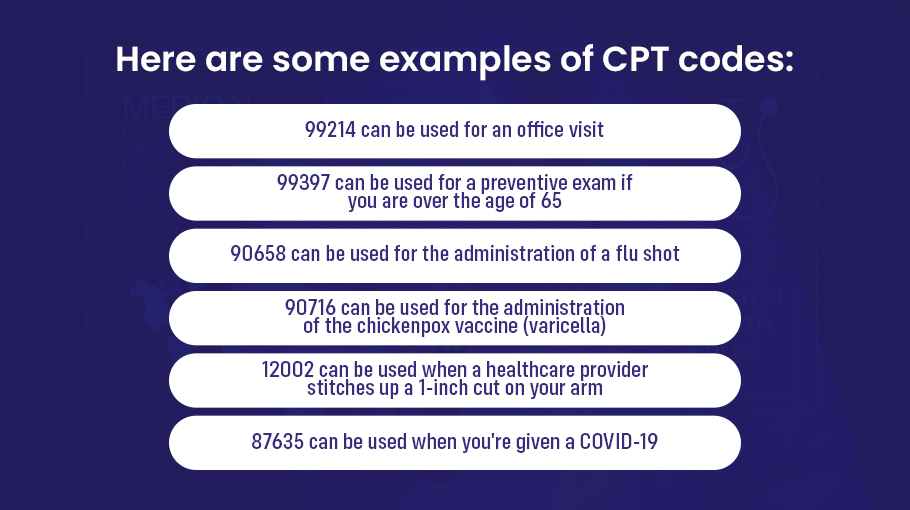
Here are some examples of CPT codes:
- 99214 can be used for an office visit
- 99397 can be used for a preventive exam if you are over the age of 65
- 90658 can be used for the administration of a flu shot
- 90716 can be used for the administration of the chickenpox vaccine (varicella)
- 12002 can be used when a healthcare provider stitches up a 1-inch cut on your arm
- 87635 can be used when you’re given a COVID-19
You can get the latest and updated list of CPT codes by clicking here.
Conclusion
CPT codes are the backbone of the medical billing process, serving as the universal language that facilitates communication, ensures accurate billing, and promotes transparency within the healthcare system. As a medical professional, it is essential to thoroughly understand CPT codes in medical billing and their proper application to protect your practice from financial losses, maintain compliance, and uphold your reputation.
By staying current with the latest code updates, investing in staff training, utilizing reputable resources, and adhering to best practices, you can ensure that your practice excels in the complex world of medical billing.
